The Birth of Aphrodite in Greek poetry
Dr Maria Hristova is assistant professor in the Ethnology and Balkan Studies Department at the Faculty of Philology of South-West University "Neofit Rilski". She took part in this year's tenth jubilee Ionian Congress with a paper entitled "The Eternal Trip to Kythira: The Image of Aphrodite Anadyomene in the Works of Dionysios Solomos, Lorentzos Mavilis and Angelos Sikelianos," examining the literary incarnations of myths associated with goddess Aphrodite in the works of these three great Greek poets.
According to the account by Homer the goddess was born at Petra tou Romiou (Πέτρα του Ρωμιού), a coastal monolith near Paphos in Cyprus. Carried by the god of the west wind, Zephyros, on the sea waves, she reached Olympus, where she was introduced to Zeus and the other gods. According to Hesiod's version of the genealogy of the gods in his Theogony, Aphrodite was born near the Ionian island of Kythira from the foam that was formed after the genitals of Uranus (Ουρανός), who was castrated by his son Cronus (Κρόνος) with the help of his mother Gaia, fell into the sea. The drops of blood gave birth to Celestial Aphrodite (Ουρανία Αφροδίτη), the goddess of love and beauty, as if Uranus was purified by sacrificing his manhood, thus creating love and perfect aesthetics. Plato says that the symbolism of this story is the existence of Celestial Aphrodite, endowed with all female sensuality, and of Eros who was born from male love. It is not a coincidence that Kythira is considered the island of Celestial Aphrodite, as her first sanctuary in the Greek lands was located there.
 Maria Hristova talks with Zdravka Mihaylova exclusively for GRReporter.
Maria Hristova talks with Zdravka Mihaylova exclusively for GRReporter.
The subject of your research is the myths about the birth of Aphrodite from the sea foam and her 'sαiling' into modern literary and cultural anthropological texts. In it you place emphasis on the intertextual presence of the ancient myth in the poetic works "Lambros" by Dionysios Solomos, "Corfu" by Lorentzos Mavilis and "Anadyomene" by Angelos Sikelianos. What does your experience in following some of the rich connotations of Aphrodite Anadyomene as an archetype and the symbol of unconscious show?
My experience shows that ancient mythology is an inexhaustible source of not only inspiration but also of self-knowledge. The myth of the birth of Aphrodite is one of the most famous and beloved myths in Greek and Western art of all ages. From ancient times to the present day, the image of the goddess who was born from the sea foam has not ceased to inspire poets, painters and sculptors, and to foster the eternal dialogue between mythology and literature. In the text that I presented at the Congress I tried to make (another) journey on the trail of the ancient goddess and to reconstruct three of her numerous incarnations in the works of these three Greek poets. I outlined the archetypal dimension of the figure and her presence in literary works. Among the many possible interpretations of the myth I focused on the image of Anadyomene as a product of the unconscious with rich and contradictory suggestions.
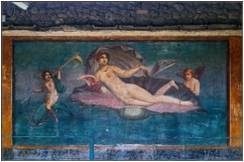 Where did the chronology of the journey in the statement you made to the Ionic Congress start?
Where did the chronology of the journey in the statement you made to the Ionic Congress start?
My personal journey to explore mythology began with my work on my Ph.D. dissertation that was associated with Ancient Greek myths and their "re-playing" in Modern Greek literature. The theme of "inter-artistry" (διακαλλιτεχνικότητα), the communication between the various arts, attracted me to the figure of Aphrodite in poetry and painting. Therefore, the journey to Kythira started with a birth in 1485, "The Birth of Venus" by Sandro Botticelli, that was inspired in turn by the description of the famous work of Greek painter Apelles. The reason for including it in the study was a comment by Karl Kerényi, a Hungarian scientist, classical philologist, one of the founders of modern studies of mythology, that the masterpiece by Botticelli depicts not the birth of Aphrodite but her arrival, considering especially her arrival among us. Indeed, nothing in the gentle girl from the seashell alludes to her dire and bloody origin. The castration of the god of the sky, Uranus, by his son Cronus, his genitals that fell into the sea, the goddess carried by the waves, her birth from the foam and rise from the waters are not present in this very impressive image of the mythological heritage.
 How did connoisseur Kerényi interpret this image?
How did connoisseur Kerényi interpret this image?
The charm and perhaps the power of mythology lie in the unlimited possibility of examining and interpreting it from various optical angles. A myth always has something to tell you, regardless of the perspective from which you explore it. Kerényi and other major "connoisseurs" of mythological stories as you call them, such as Campbell, Neumann, Jung, consider the famous goddess of love as a psychic reality, an archetypal figure of vital importance for the soul. According to Kerényi the figure of Anadyomene, emerging from the seawater, precedes the arrival of Aphrodite in the mainland, and this image helps us to understand the goddesses of ancient Greeks, as Aphrodite Anadyomene "is the one who is closest to the roots."
What do we actually know about Aphrodite? Do we really know her? In ancient times, in addition to the earthly aspect (Πάνδημος) of Aphrodite, the patroness of the wild and passionate love between young people and of aspiring souls in love, another Aphrodite, namely the Celestial Aphrodite (Ουρανία), dominates in the sky like a black Madonna. She is one of the most enigmatic figures created by the human unconscious. Celestial Aphrodite, called Μέλαινα, (Meliae, i.e., Black, Dark), was a goddess of destruction, darkness, chaos, ruthless opposition. She did all that not because of viciousness but because she wanted to revitalize and renew the whole universe through love. Of course, we are talking about a love of cosmic dimensions in which galaxies absorb other galaxies to merge with them, to achieve unity, completeness, and the sole and absolute being. Aphrodite also had 'avatars' such as Medea, Ariadne, Scylla, Hecate and they have developed into separate deities or mythological figures over time.
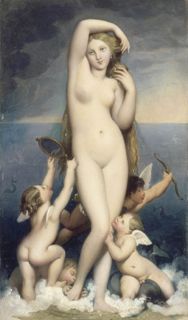 Yes, mythological figures have the ability to merge into one other, to pull toward themselves contradictory and seemingly exclusive features. Black Aphrodite (as well as "apocryphal" Black Demeter) is almost unknown, she is lost to us. We know Aphrodite as "gold-crowned" and "beautiful", "sweetly-winning", "coy-eyed", "fulgent", "all-golden", "with a sweet and charming smile"; we find it difficult to recognise her as Melainis. According to Pausanias, the ancients called her "Black" because the sexual act of humans takes place during the night. According to French philosopher and anthropologist Jean-Pierre Vernant, however, this multifaceted goddess is a product of the ancient mythological thinking and her figure expresses the perception of the world as a result from the constant mixing of opposites. He pays special attention to the retinue of the goddess of love, which includes the children of the Night, Nyx (Νυξ), Fraud (Απάτη/Εξαπάται) and Loving Tenderness (Φιλότης). In the eyes of Vernant, besides being the patroness of beauty, joy and love Aphrodite was one of the female figures of death in antiquity.
Yes, mythological figures have the ability to merge into one other, to pull toward themselves contradictory and seemingly exclusive features. Black Aphrodite (as well as "apocryphal" Black Demeter) is almost unknown, she is lost to us. We know Aphrodite as "gold-crowned" and "beautiful", "sweetly-winning", "coy-eyed", "fulgent", "all-golden", "with a sweet and charming smile"; we find it difficult to recognise her as Melainis. According to Pausanias, the ancients called her "Black" because the sexual act of humans takes place during the night. According to French philosopher and anthropologist Jean-Pierre Vernant, however, this multifaceted goddess is a product of the ancient mythological thinking and her figure expresses the perception of the world as a result from the constant mixing of opposites. He pays special attention to the retinue of the goddess of love, which includes the children of the Night, Nyx (Νυξ), Fraud (Απάτη/Εξαπάται) and Loving Tenderness (Φιλότης). In the eyes of Vernant, besides being the patroness of beauty, joy and love Aphrodite was one of the female figures of death in antiquity.
What archetypal figure can be distinguished in the figure of Aphrodite?
One of the most fundamental archetypes of human psychological reality can be discerned in the figure of Aphrodite from the perspective of analytical psychology, namely the archetype of the Great Mother Goddess. Love and death, the womanly and the nocturnal, the good and the terrifying aspect of an undifferentiated primary figure of femininity that expresses the female spirit through the language of 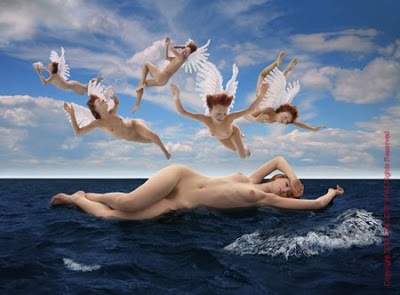 myth meet and intersect in this archetype. According to German psychologist Erich Neumann, Renaissance Venus is a replica of the great goddess of antiquity crippled by patriarchal thinking and reduced to a symbol of love and sexuality. Moreover, in the figure of Anadyomene we can find the primeval mythological idea of the birth and the beginning embodied in the two major stories of antiquity about the divine child and the Goddess Cora (an alias of Persephone). Aphrodite represents and expresses the inseparable mother-and-daughter dyad traditionally embodied by Demeter and Persephone, containing at the same time the aspects of the Great Mother and the young seductress. Although we are used to associating her name with different love affairs, at the time of her emergence from the sea foam, she is η Πρωτόγονη Κόρη, the Primary Virgin, the divine personification of birth, purification and renewal.
myth meet and intersect in this archetype. According to German psychologist Erich Neumann, Renaissance Venus is a replica of the great goddess of antiquity crippled by patriarchal thinking and reduced to a symbol of love and sexuality. Moreover, in the figure of Anadyomene we can find the primeval mythological idea of the birth and the beginning embodied in the two major stories of antiquity about the divine child and the Goddess Cora (an alias of Persephone). Aphrodite represents and expresses the inseparable mother-and-daughter dyad traditionally embodied by Demeter and Persephone, containing at the same time the aspects of the Great Mother and the young seductress. Although we are used to associating her name with different love affairs, at the time of her emergence from the sea foam, she is η Πρωτόγονη Κόρη, the Primary Virgin, the divine personification of birth, purification and renewal.
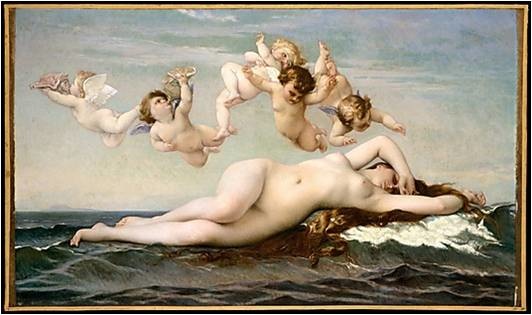
Why did you turn to these poets and works?
Among the many incarnations of Aphrodite in literature I preferred three Ionian-island poets, because the scientific forum was devoted to the Ionian culture, literature and history. Kythira, incidentally, is one of the Ionian Islands, but I put into "The Eternal Journey to Kythira" the idea of the eternal return to mythology as a source of the greatest truths, a return to the roots, if you will. Dionysios Solomos (1798-1857) from the island of Zakynthos, Lorentzos Mavilis (1860-1912), born on the island of Ithaca, and Angelos Sikelianos (1884-1951) from the island of Lefkada are not the only Greek poets inspired by this figure, but even the three selected short poems show how masterly the figure arranges and rearranges its meanings, undergoing transformation and being born again and again, thus bringing each time new messages. For example, "Corfu" by Lorentsos Mavilis was written as a palimpsest over 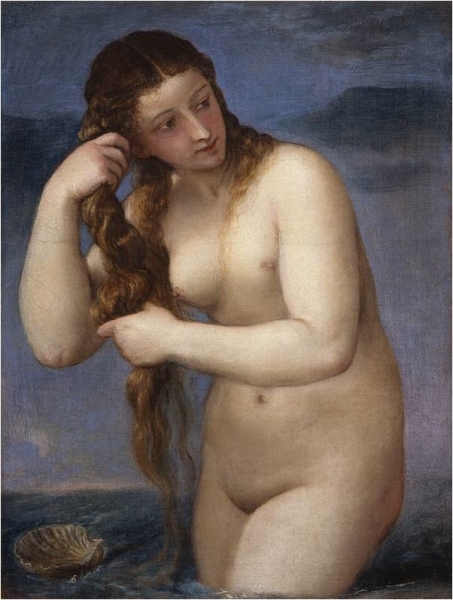 the mythological version of the double birth of Aphrodite and of the island of the Phaeacians, just like it is preserved in "Argonautica" by Apollonius of Rhodes (3rd century BC) that tells the myth of the voyage of Jason and the Argonauts to Colchis in search of the Golden Fleece. In the fourth book of the epic, the sickle (δρεπάνη) of the terrible emasculation pairs with the reaping hook of goddess Demeter. The emergence of the island and the birth of the deity intersect and intertwine in a double theogony, the symbol of the moon and fertility being their common denominator. This mythological motif of the Hellenistic text was "rewritten" by Mavilis who is the author of some of the finest sonnets in Greek poetry.
the mythological version of the double birth of Aphrodite and of the island of the Phaeacians, just like it is preserved in "Argonautica" by Apollonius of Rhodes (3rd century BC) that tells the myth of the voyage of Jason and the Argonauts to Colchis in search of the Golden Fleece. In the fourth book of the epic, the sickle (δρεπάνη) of the terrible emasculation pairs with the reaping hook of goddess Demeter. The emergence of the island and the birth of the deity intersect and intertwine in a double theogony, the symbol of the moon and fertility being their common denominator. This mythological motif of the Hellenistic text was "rewritten" by Mavilis who is the author of some of the finest sonnets in Greek poetry.
What would you tell our readers in conclusion regarding this widely commented-upon and very ambiguous female mythological figure?
The archetype of Aphrodite Anadyomene and its many manifestations in literature, sculpture and painting are almost an endless subject. This short journey on the trail of the goddess from Kythira aimed to show (once again) the infinite power of myth to transform and to produce new meanings, to build new meaningful complexes. I would end with the words of Karl Kerényi that very well summarize the presence of myth in our world, "Mythology like the severed head of Orpheus continues to sing even beyond death."